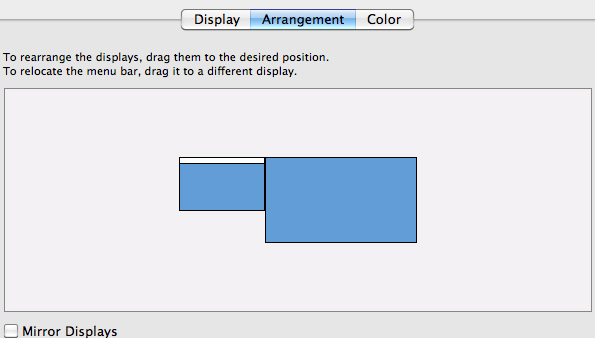Promise Pegasus R6 & Mac Thunderbolt Review
by Anand Lal Shimpi on July 8, 2011 2:01 AM ESTDisplayPort Passthrough
The Pegasus has two Thunderbolt ports. You can use the second port to daisy chain up to six Pegasus devices together, for up to 36 drives. With a single Pegasus in its default configuration able to hit over 5Gbps, you'd definitely run into bandwidth limitations with six of these things. But you could get by with two and not be limited by Thunderbolt.
There's another role that second Thunderbolt port can play: as a DisplayPort output. Remember both PCIe and DisplayPort are carried on a single Thunderbolt cable, the latter occupying half of the 40Gbps of total bandwidth available.
At the end of a Thunderbolt chain you can insert a miniDP display, currently the only option is the 27-inch LED Cinema Display but in theory other panels that accept a miniDP input could work as well.
I connected a 27-inch Cinema Display through the Pegasus without any problems. The Pegasus does have to be on for you to get video however, so if you ever have to shut down the Pegasus you do lose video to the Cinema Display.

Audio still works, so you'll see the Cinema Display as an audio device on your Mac:

The experience is pretty seamless overall.
I ran a quick test to see if I lost any bandwidth to the Pegasus with the 27-inch Cinema Display in the chain. I measured a slight performance drop (< 3%) in the best case scenario of four SF-2281 SSDs in a RAID-0 array on the Pegasus, but nothing substantial at all. Note that simply displaying an image at 60Hz on the 27-inch Cinema Display requires over 6.75Gbps of bandwidth (because of 8b/10b encoding), so a full Thunderbolt channel is necessary for DisplayPort (although admittedly it only needs to be unidirectional bandwidth).
| Thunderbolt PCIe + DP Bandwidth Test | ||||
| 2MB Sequential Write, QD16 | No DisplayPort Passthrough | 27-inch Cinema Display Connected | ||
| Promise Pegasus R6 (4 x SF-2281 SSDs, RAID-0) | 1002.7 MB/s | 988.2 MB/s | ||










88 Comments
View All Comments
Spazweasel - Friday, July 8, 2011 - link
$50 too much for a cable? Psshh. Children these days don't remember $75-100 SCSI-3 and UltraSCSI cables. These things are expensive for good reason.You want the highest performance, you pay to play. That's always been the case.
tzhu07 - Friday, July 8, 2011 - link
The phrase, "you get what you pay for" is generally true as a rule of thumb, but in the computer and consumer electronics industry, that has for the most part been untrue.Case in point: The high price of Monster cables having no performance advantage over the same type of cables one can find on newegg at a much lower price.
Apple just has this technology cornered....for now.
tzhu07 - Friday, July 8, 2011 - link
Well, I should say untrue in the computer and consumer electronics cable market.darwinosx - Friday, July 8, 2011 - link
The technology is Intel's not Apples. Intel determines the licensing fees.Samus - Friday, July 8, 2011 - link
Yes, but like SCSI, Apple was its only mainstream delivery vehicle. Back in the 80's and 90's, SCSI interfaces were reserved for servers, ultra high end workstations, and Apple computers. They always push the bleeding edge, which is possibly the only thing I respect about Apple.Justin Case - Saturday, July 9, 2011 - link
This has nothing to do with "pushing the bleeding edge". This has to do with giving Apple an "excuse" to remove USB ports from their iToys, thus locking out 3rd party accessory manufacturers (Thunderbolt is far too expensive to be competitive, unless you have a special deal like Apple has with Intel).The Mac hasn't been Apple's main focus for a long time; it's all about iOS and its ecosystem, now.
haley2011 - Sunday, July 10, 2011 - link
okMySchizoBuddy - Sunday, July 10, 2011 - link
doesn't the article specifically say that thunderbolt is free to license.Isn't Promise Pegasus a 3rd part manufacturer. Do you have any source claiming that Promise has a special deal with Apple.
Sony has thunderbolt ports in it's laptop as well.
Focher - Sunday, July 10, 2011 - link
Besides that you give away your bias of anything from Apple, TB isn't an Apple technology. It's an Intel one. What I find ironic is the USB versus TB arguments. First, it's a false choice. Even Apple has offered both FireWire and USB ports for years on their machines. It's only recently that FireWire has started to be removed from models. There's no current indication that USB will be dropped by Apple. Second, in specific regards to USB 3.0 I don't see the argument versus TB device availability. Neither have much market penetration yet, so only time will tell how each of them will do - and both could do fine or both could fail.MobiusStrip - Tuesday, July 12, 2011 - link
iOS devices are toys, but they already lack USB ports. They don't have any proper developer- or user-accessible I/O, so you think Apple's going to put Thunderbolt ports on them?NO. Apple has created a whole line of mobile devices that are ironically isolated from the world around them.